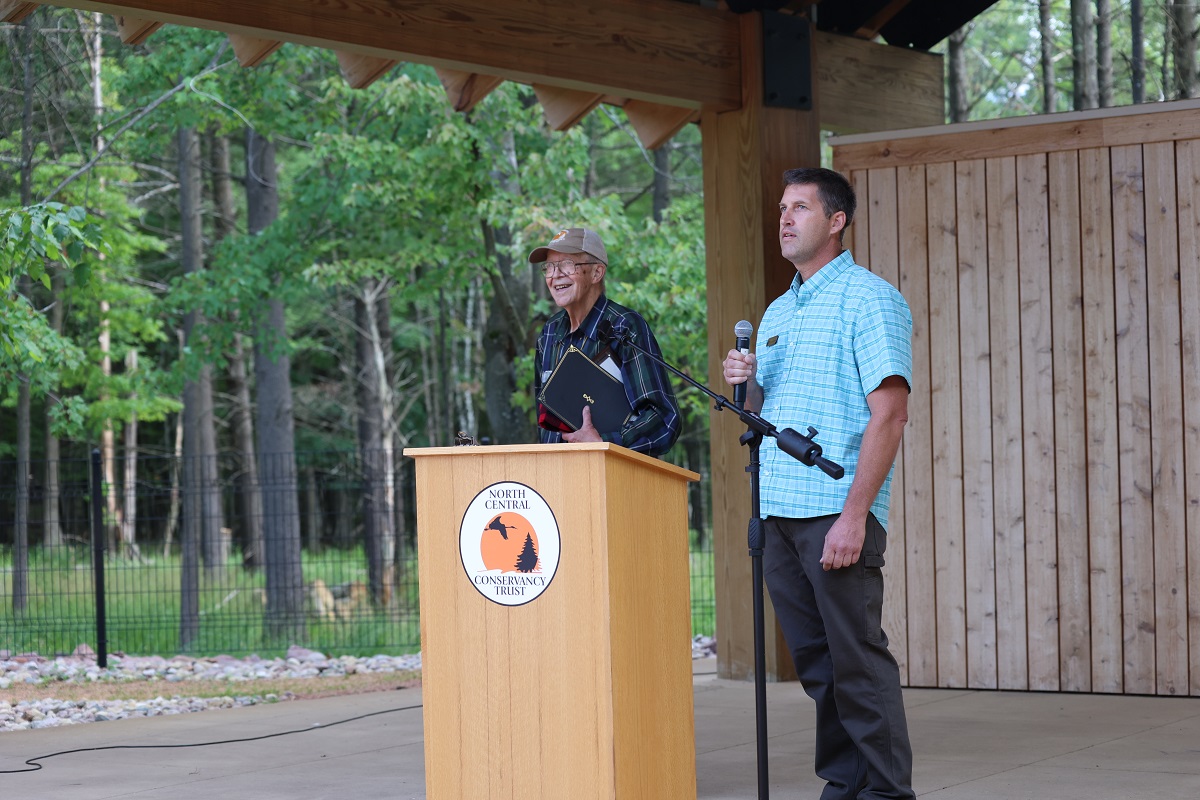Emeritus Professor of Biology Bob Freckmann isn’t one for drawing attention to himself and his legacy of nature conservation. But he is hopeful that his land conservation leadership award, the Harold “Bud” Jordahl Lifetime Achievement Award, will draw attention to one of the largest land stewardship organizations in Wisconsin, the North Central Conservancy Trust (NCCT).
Freckmann was a founding member of the NCCT in the 1990s. Since its origin, more than 5,000 acres in eight counties have been set aside permanently as conservation easements. The donated parcels are protected from development, as directed by the landowner’s vision.
“I see myself as an excuse to talk about the organization,” Freckmann said.
Freckmann has long committed to the NCCT because it allows an average person to do something tangible for environmental conservation, he said. He joins the initial site visits whenever he can and helps the land trust to determine through his botany surveys, whether the properties fit their criteria for easement protections. He and his late wife, Sally, decided to put an easement on a portion of their property in Stevens Point decades ago.
That space turned into an outdoor classroom for many of his biology students at UW-Stevens Point. The trusted field biologist retired from his teaching career in 2001 but he continues to educate the wider community.
Supporting Community with Expertise
 Freckmann is pictured with Chris Radford, NCCT executive director, as he presents him with his award.
Freckmann is pictured with Chris Radford, NCCT executive director, as he presents him with his award.
Freckmann is a trusted adviser on a host of conservation projects in Portage County and across the state. After all, he collected and donated some of the very first plant and grass specimens for what would become the UW-Stevens Point Herbarium —now called the Robert W. Freckmann Herbarium.
In large part due to the contributions of students and volunteers, he said, the collection has grown to a quarter of a million specimen records. It is now a tremendous scientific resource of vascular plants, grasses, bryophytes, and lichens, the second largest herbarium in Wisconsin.
Former students, like UW-Madison research technician John Zaborsky, gained a deep appreciation for the importance of plant diversity while working with the Herbarium collection. Zaborsky enthusiastically worked under Freckmann’s supervision, carefully preserving and filing away the plant specimens for later study. Twenty years later, he remains in contact with Freckmann, attending biodiversity-focused events together.
“I think Bob has made it a goal to teach anybody and everybody about the natural world that he so obviously cares about,” said Zaborsky. “There’s a general thirst for that type of knowledge and we don’t have a lot of people doing that work.”
Much of the careful sample preservation and identification necessitates that the work is done by hand. Mobile apps come close, but they don’t measure up to the level of specificity that can be found researching tens of thousands of curated records of Wisconsin flora in the impressive UWSP plant inventory.
“We know that he’s dedicated his life to conservation and contributed to the scientific body of knowledge and he is still curating today,” said Chris Radford, NCCT executive director.
Protecting the Ecosystem
Radford said the Lifetime Achievement Award is a way to show their gratitude for the resources and knowledge Freckmann regularly shares over his decades of service. His enthusiasm is evident when he leads interpretive hikes for the public, pointing out the ecological features of note. His keen eye in identifying native plant species and invasive species makes Freckmann a “botany celebrity” and amplifies the conservation mission of the NCCT, Radford said.
Kerry Brimmer chairs the Properties Committee for NCCT and worked closely with Freckmann on the board throughout the lean years of the land trust, he said. Freckmann’s expertise has helped them to gain real traction in their work and in conveying the benefits of conservation easements for the natural environment.
“Bob brings a breadth of knowledge that is not equaled,” Brimmer said. “He is always willing to walk the land, he epitomizes volunteerism!”
The landowners who choose to set aside properties through the NCCT can stipulate whether the public has access to use the easements. Dozens are now open to the public year-round.
“Landowners say it’s an honor to have him visit their properties,” said Radford. “They value him and his opinion. Bob takes it to a whole other level of describing the plants in such detail, with a holistic view to help people to understand the interconnectedness.”
Freckmann said he can’t imagine himself not working to document, protect and conserve Wisconsin’s natural heritage.
“It’s what I am,” he said. “By having parcels in the trust, the biological diversity that is preserved then protects us from so many things that can go wrong.”
The more variety of organisms that live, the better it preserves and maintains wildlife habitat, prevents the movement of invasives, and protects wetlands and forests for future generations against threats such as fire and drought.
“It’s your opportunity to do something that will last long into the future.”
